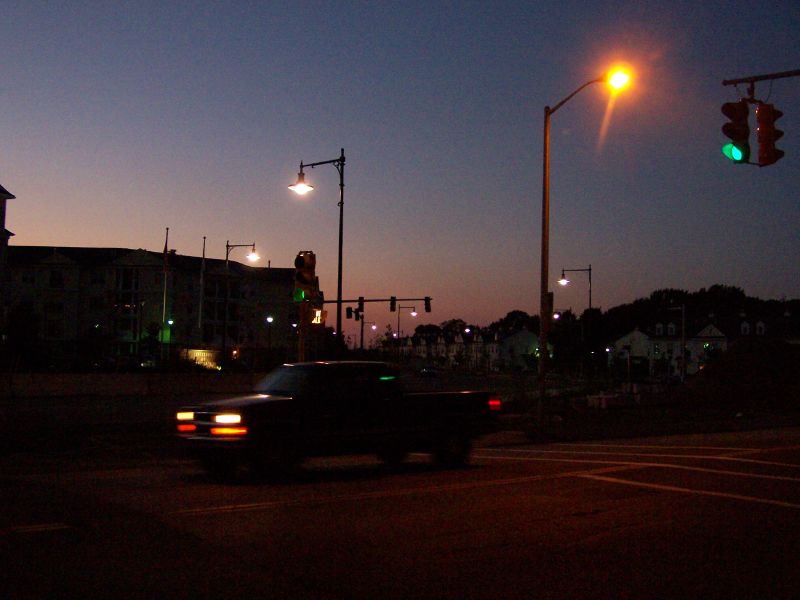
[Bridge & St. Peter St at sunset, looking towards the bypass road.]
For once, there's an op-ed in a Salem paper I'm not screaming at (*cough* Taylor Armerding *cough*). Robert Moran's column in the Gazette, Salem as a change leader, says out loud what I've been trying to say in this blog: Salem has never been able to adapt to the Car Culture of the post-1950's and it should not have even tried.
Salem is often compared to other cities in the region like Peabody and Beverly that have direct access to major highways like 128 and 95. Why can't Salem have these, people ask? The Northshore Mall has a parking lot that is as big as the core of downtown Salem; why can't Salem have one that size?
Why can't Salem have more cars on the streets? Why can't Salem have more parking? Every so often, a business leaves Salem, such as the old Sears Credit in Shetland Industrial Park, and the refrain is, "Oh, if we had more cars/roads/parking, they wouldn't have left!"
Salem is a small city, just over 8 square miles of land. Virtually all of the developable land (apart from wetlands and parklands such as Forest River and the Salem Woods) has already been developed. Most development in Salem is of existing properties, such as Derby Lofts, and the soon-to-be-redeveloped Salem News building.
I've written before about the Bridge Street Bypass Road. That road took 30 years to get built and became a much shorter road than was originally proposed. The rancor surrounding this project has been so great that it's unlikely we'll ever see another project like that in our lifetimes.
Nor should we.
But it will take more than my desires to change things. To quote Moran:
While dreamers imagine utopia, many shiver as chill sweeps the spine: “How would I get anywhere? I’d have to buy a horse. The city would stink of horse poop. Either that, or I’d spend life tethered to a bureaucrat’s schedule, hanging around bus stops, and hoarding change.”
I'm delighted at the thought that the property-values activists on Federal St. may have to own horses and park them on the sidewalk instead of their SUV's, but kidding aside, there's a truth there.
Public transportation in Salem, as in most of the state, is a non-starter for most households in the city right now. There is no way one can ask the head of a family to wait in the snow or the rain outside Market Basket for the #450 bus that only runs every hour and that is usually late.
Back in the day, there were groceries like Salem Market (now Red Lion Smoke Shop) and Finast (now a Walgreens) downtown. The Boston St. area had Giant Valu, then Crosby's, then nothing. Repeat this for clothing stores, sporting goods and so forth. How many bakeries were there downtown back in the day? Versus now? (only A&J King on Derby St. and they survive on the Derby Loft yuppie traffic.)
You can't live on the shops downtown.
Even the number of convenience stores in our neighborhoods has declined; it's easier to drive a quarter-mile to Hess or 7-11.
Highland Ave. has all the retail, but it is a miserable place for pedestrians and T riders to navigate. (Try coming back from Walmart and crossing the street to get your bus back. With kids. Good luck.)
Ultimately, I'm pessimistic over the prospects of alternative transportation. It'll take a crisis like the Second Energy Crisis to motivate people and even then they have to be convinced things won't change by the closing credits.
But it's good to have at least a few people in the street aware of these things.
No comments:
Post a Comment